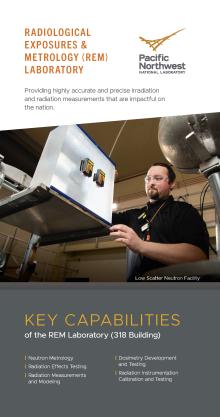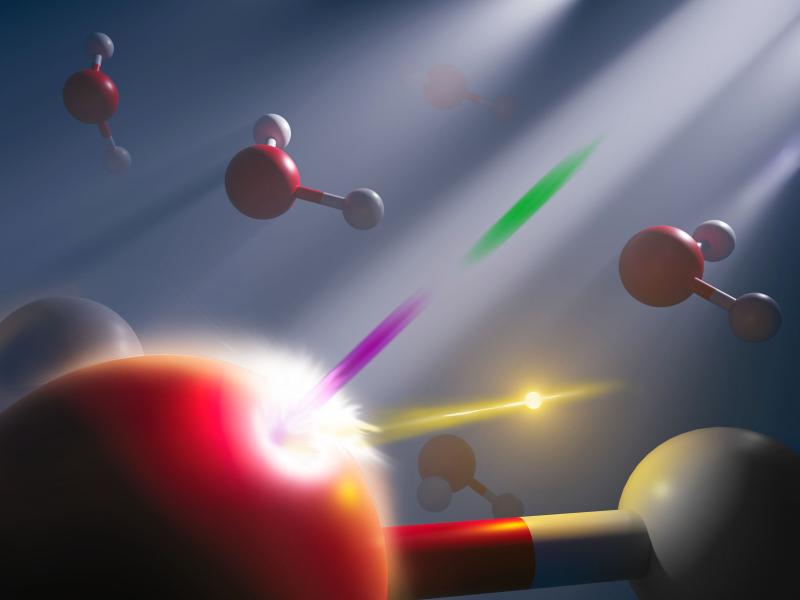
Radiation
Measurement
Radiation
Measurement
Using irradiation science
to determine human exposure
and to test key equipment
Using irradiation science
to determine human exposure
and to test key equipment
A PNNL researcher conducts calibration using a Neutron Criticality Detector (NCD) and a source well.
Andrea Starr | Pacific Northwest National Laboratory
Research capabilities for radiation measurement and irradiation science at PNNL focus on the effects of dosage on humans, equipment, and nuclear power reactors. Both the 318 Building—also known as the Radiological Exposures & Metrology (REM) Laboratory—and the Radiochemical Processing Laboratory (RPL) have lab space dedicated to researching and applying specialized technologies, some of which are not available or licensed anywhere else in the United States.
Radiation Dosimetry
With nuclear science spanning several of its core research missions, PNNL uses its facilities and expertise to track and study the effects and severity of radiation exposure. PNNL has a depth of experience in all areas of radiation dosimetry—including radiation worker protection, medical and industrial radiation processing, and radiation biology—and in shielding-effectiveness studies.
PNNL’s proximity to the Hanford site has resulted in more than half a century of expertise in health physics, research design, Monte Carlo modeling, cobalt-60 gamma irradiation of samples, nondestructive assays, environmental testing, and metrology. Much of this research occurs in the 318 Building, with capabilities to support more than 100 accredited radiation fields covering a wide range of nuclides and energies. For example, the highly specialized Dosimetry Lab houses four different types of radiation detection systems that cover nearly any type of exposure that requires radiation dose measurement.

Irradiation Science
Materials and equipment used in radioactive environments need to be protected from radiation. For example, the expense associated with installing electronic devices—such as a camera into an underground tank storing nuclear waste—can be exorbitant, so it is prudent to first find out how long the camera will hold up in that extreme setting. PNNL provides this service for federal and industrial institutions by irradiating the equipment components with the predicted dosage—such as low-scatter neutrons, high-dose gamma from cesium-137 or cobalt-60, beta sources, or 320-kilovolt X-rays—and measuring the effects on the integrity of the materials. Scientists also assess how temperature and humidity affect items. Additionally, PNNL supports the nuclear industry by performing dosimetry proficiency testing and radiological instrument calibrations.
Reactor Dosimetry
One of the most challenging aspects of nuclear energy is providing the scientific proof that a nuclear reactor is safe to operate. Reactor dosimetry allows researchers to verify that calculations of neutron fluence and radiation damage to reactor materials are reliable. PNNL researchers at RPL developed this capability nearly three decades ago.
Dosimetry monitor capsules are custom designed and constructed in RPL. They are built with 14 or more pure and well-characterized materials, based on the reactor environment. Using in situ activation and melt-wire measurements, the capsules indicate the temperature and radiation exposure at various locations inside the reactor and at the pressure vessel. These monitors are used on vessels around the world, including in universities, laboratories, and commercial sites in Europe, Asia, and across the United States. The U.S. Nuclear Regulatory Commission relies upon PNNL technical experts to verify calculations of the neutron fluence and radiation damage, which indicate the lifetime of an operating reactor pressure vessel.
Detecting airborne radioactivity
Within RPL, PNNL operates the only radionuclide laboratory in the United States certified by the International Monitoring System of the Comprehensive Nuclear-Test-Ban Treaty Organization (CTBTO). It’s one of just 13 radionuclide laboratories worldwide certified to process air particulate samples collected from a network of about 80 stations. The CTBTO’s mission is to detect radioactivity from nuclear explosions and emergencies, such as the tsunami that struck the Fukushima power plant in 2011, and to track the spread of radioactivity. CTBTO uses the data to inform international policy and response.
Research into radiation and nuclear energy is present throughout PNNL’s missions of national security, scientific discovery, and energy resiliency. The work by PNNL scientists in radiation measurement has increased safety and made it possible to explore new developments in these areas.

